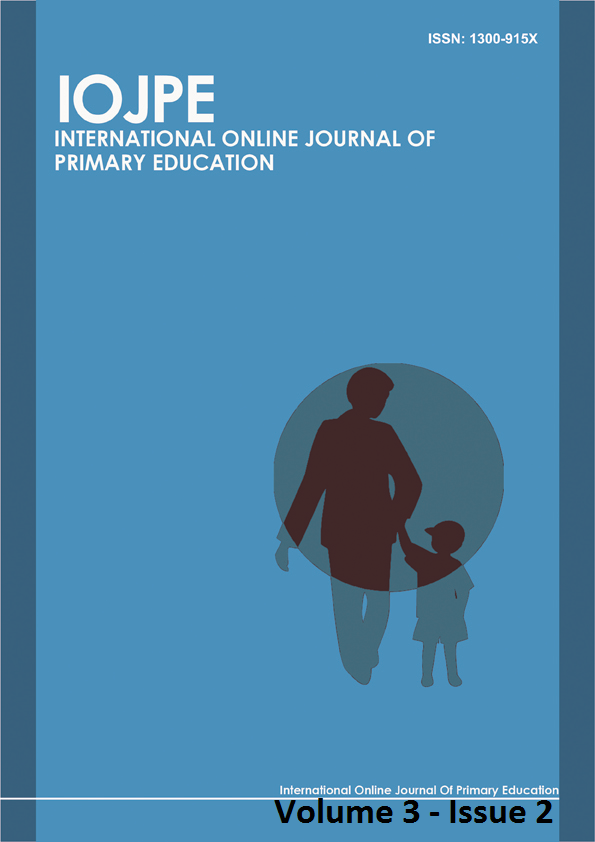SAMPLE APPLICATIONS FROM MATERIAL DESIGNS PREPARED FOR VARIOUS PRIMARY SCHOOL CLASSES
Abstract
In the present study, the importance of using material in teaching at primary school is emphasized. Moreover, it is aimed to introduce teaching materials prepared for different classes by candidate teachers. For this reason, 18 students’ designs from Primary School Teaching Division of Faculty of Education are presented. Candidate teachers who prepared those designs first choose their interested topics from different courses which they will give at primary school. It is emphasized that materials should be simple, clear, easy to use for the student, made from durable material, should make the topic more concrete, but that they shouldn’t include too many details about the chosen topic. Designing materials can be considered as a part of learning experience by living and doing by candidate teachers. It is very important that candidates should design materials and that they should be encouraged to use them when they are doing their internship and later on in their professions. In this regard, “Instructional Technologies and Material Design” course, which has been given a single term four-credit course at Primary School Teaching Division, should be offered as a four-credit course in two terms. Furthermore, it might be suggested that current primary school teachers should be encouraged to develop and use materials and provided with practical applications by within-service seminars and that sharing of functional teaching materials should be provided.
Keywords: Material design, material design in primary school, candidate teachers.
REFERENCES
Aslan, K., Aslan, N., & Arslan Cansever, B. (2012). Egitim bilimine giris [Introduction to education], Pegem Akademi, Ankara.
Arslan Cansever, B. (2013). Material designs in education, The Learning Teacher Magazine, The Learning Teacher Network, Volume 4, No:1/2013,p.3,Sweden, ISSN: 2000-2610.
Aykac, N. (2012). İlköğretim öğrencilerinin resimlerinde öğretmen ve öğrenme süreci algısı [Perceptions of the Teacher and Teaching Process in the Drawings of Elementary School Students], Eğitim ve Bilim, (37) 164, 298-315.
Heinich, R., Molenda, M.,& Russell, J.D. (1993). Instructional Media and The New Technologies of Instruction, 4th. Ed., England: Macmillan Publishing Company.
Howe, A. C.& L. Jones, (1998). Engaging Children in Science. New Jersey. USA: Prentice-Hall. Inc.
Ornstein, A. C., & T. J. Lasley. (2000). Strategies for Effective Teaching. Third Edition. USA: The McGraw-Hill Companies.
Rotter, K. (2006). Creating Instructional Materials for All Pupils: Try COLA Intervention in School and Clinic 41; 273-282.
http://isc.sagepub.com/cgi/content/abstract/41/5/273
Sahin, T.Y. & Yildirim, S. (2004). Öğretim Teknolojileri ve Materyal Geliştirme, Ankara: Anı Yayıncılık.
Yalin, H.İ. (2003). Öğretim teknolojileri ve materyal geliştirme, Ankara: Nobel Yayınları.
Yigit, N. (Ed.) (2007). Öğretim teknolojileri ve materyal tasarımı, Tarbzon: Akademi Kitabevi.
YOK (2003b). Bilgisayar ve Öğretim Teknolojileri Öğretmenliği Lisans Programı. [online] T.C. YüksekÖğretim Kurulu web sayfası. Erişim Tarihi 16.04.2003, http://www.yok.gov.tr/egitim/ogretmen/ogretmen_yetistirme_lisans/bilgisay.doc
Winn, W. & Halliday, W. (1982) Design Principles for Diagrams and Charts, Englewood Cliffs, NJ: Prentice Hall, USA.
Downloads
Published
Issue
Section
License
Copyright (c) 2021 International Online Journal of Primary Education (IOJPE) ISSN: 1300-915X

This work is licensed under a Creative Commons Attribution-NonCommercial 4.0 International License.





